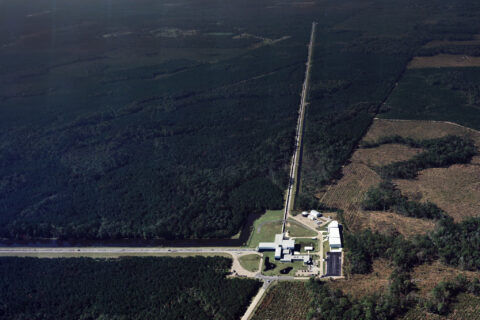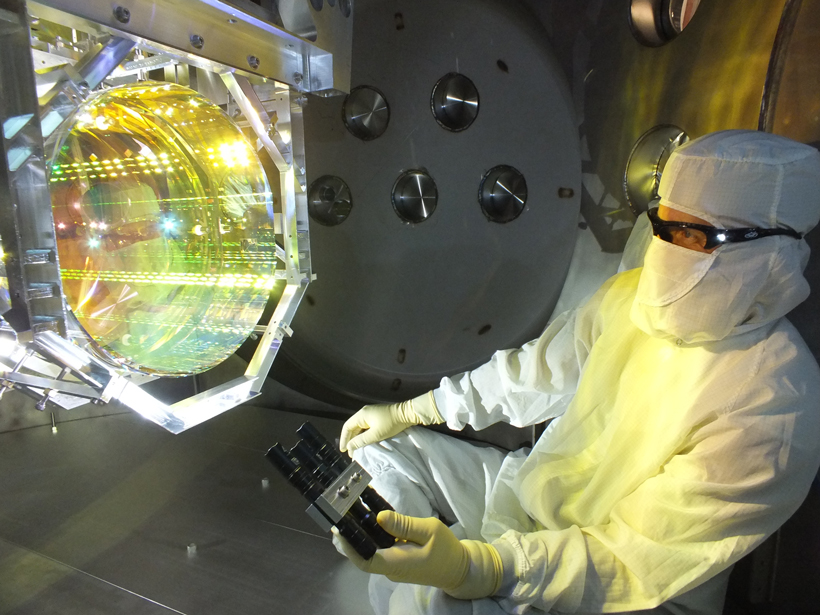Behind the scenes of last week’s historic gravitational waves announcement lies a story of astrophysics leaning heavily on geophysics. It’s a tale of how the scientists and engineers of the Laser Interferometer Gravitational-Wave Observatory (LIGO) managed to find the signal of a subatomic-scale variation in the fabric of space from an observatory rooted on a seismically clamorous planet.
LIGO detected a pulse of gravitational waves that altered the length of the laser beams used to measure the two 4-kilometer arms of the project’s two facilities by an absurdly small amount.
“We quote some crazy numbers: 10−19 meters.”
“We quote some crazy numbers: 10−19 meters,” said Anamaria Effler, a LIGO researcher at the California Institute of Technology (Caltech) in Pasadena. That’s a ten-thousandth of the diameter of a neutron. How can they find that needle in Earth’s seismological haystack? Sometimes they can, and sometimes they can’t.
The Need to Control Seismic Noise

The ripples in space time that caused the pulse emanated from the collision of two black holes 1.3 billion light years away that had circled each other and then suddenly merged, a team of scientists announced on Thursday. The first step to detecting that colossal, but exquisitely far away, event lay in controlling seismic noise by locating the two LIGO detectors in relatively quiet places.
“We of course benefit with the lower seismic noise of the sites,” said Peter Fritschel, senior research scientist at the LIGO Project at the Massachusetts Institute of Technology in Cambridge. “But we can’t put them in the middle of nowhere,” he added, because they need to be accessible to people who work on them. One resides near Richland, Wash., and the other near Livingston, La. So seismic noise from human activities creates interference in both of these areas.
Playing Keep Away
To isolate the LIGO detector’s core optics from seismic jitters, multiple layers of springs, actuators, and pendulums counteract vibrations and dissipate seismic noise. Seismic isolation begins with a spring-mounted framework resting on the ground. On it stands the second stage: a double-decker platform, with each deck suspended from springs and other controls. This stage 2 also includes three broadband seismometers and six geophones for monitoring seismic noise.
From the center of stage 2 hang the mirrors that reflect the lasers used to detect changes in the lengths of the arms of LIGO. The mirrors dangle from the end of a quadruple pendulum, which, as its name implies, hangs in turn from a second pendulum hanging from a third pendulum, all of which are suspended from the second stage platform. Add up all those layers and pendulums, integrate them with computer controls, and you get seven stages of isolation of LIGO’s optics from the Earth’s tremors. That knocks those jitters down by a factor of more than a billion, explained Stanford University’s Brian Lantz, lead scientist for the Advanced LIGO Seismic Isolation subsystem.
All that technology can’t always hold off an uncooperative planet.
All that technology, however, can’t always hold off an uncooperative planet.
“There are still things to work on in battling the seismic environment,” said Fritschel. Earthquakes can overwhelm the instrument, microseisms from ocean waves can invade its target bandwidth, and even the wind blowing on the LIGO buildings can pose a challenge.
Quakes, Storms, and Wind: Oh My!
“Earthquakes will simply knock us out, and we have to wait for Earth to stop ringing,” said Effler. Storms in the Gulf of Mexico can create so much noise that LIGO researchers in Louisiana just have to go home and wait it out, she said. Even the wind blowing on the buildings at the Washington State site can create too much seismic noise.
“Another thing we are still working on is resistance to earthquakes,” said Fritschel. Even a few seconds’ warning of incoming seismic waves from a quake would make LIGO a lot more robust, he said.
Ultimately, there will always be some bands where ground-based gravitational wave observatories just can’t observe, said Fritschel.
In LIGO’s current configuration, if its instruments experience shaking slower than 10 cycles per second, the pendulums can’t cancel it out. The remedy for this deaf zone in LIGO’s gravitational hearing is the same one sought by astronomers endeavoring to explore the universe in X-rays and other wavelengths that don’t reach Earth’s surface: observe from space. To fill that void, LIGO’s cousin has been under development: the Laser Interferometer Space Antenna (LISA). Not only will LISA (or its kind) not be limited by seismic noise, but it will easily have greater arm lengths, which will enable the instruments to detect even subtler quivers in the fabric of space and time.
Detectors on Earth and in Space
LISA will likely only complement, not replace, ground-based observatories like LIGO, which means the marriage of geophysics and astronomy is likely to go on for a while.
“Geophysicists are very good at listening to the ground,” said Lantz. “We’re very happy to be working with geophysicists on this.”
—Larry O’Hanlon, Independent Science Writer and AGU Social Media Coordinator
Correction, 18 March 2016: An earlier version of this article exaggerated a length compared to the diameter of a neutron and provided an incorrect date. This article has been updated to accurately state the comparison and the date.
Citation: O’Hanlon, L. (2016), Seeing the gravitational waves, despite the seismic waves, Eos, 97, doi:10.1029/2016EO046251. Published on 17 February 2016.
Text © 2016. The authors. CC BY-NC 3.0
Except where otherwise noted, images are subject to copyright. Any reuse without express permission from the copyright owner is prohibited.

